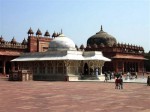Built by the Mughal Emperor Akbar, this royal city was a one of a kind! During the days of Akbar, the most prominent of the Mughal emperors, it was the capital of Mughal India. Today it is an imperial ghost city… one that haunts tourists with its captivating beauty! This is the spectacular Fatehpur Sikri, one that cannot be described in words only experienced! To know more about this exquisite city, read on…
Built during the second half of the 16th century by one of the greatest and best Mughal leaders to have ruled India, Emperor Akbar, Fatehpur Sikri (the City of Victory) boasts of a unique blend of different architectural traditions. While the general layout and concept of the buildings conform to the Islamic style of architecture, the actual buildings (mainly palaces), their ornate columns, arches, carving style, etc., show a strong Hindu style in general and that of Gujarat and Rajasthan in particular.
Having ascended the Mughal throne at the tender age of 14, after the sudden demise of his father, Humayun, Akbar turned his attention towards building an imperial capital in Agra as soon as he consolidated his power.
Resulting in the Agra Fort, this was not only used for military purposes, but also as the royal residence. However, in course of time, Akbar decided to shift his capital to Fatehpur Sikri near Agra, as he used to visit the hamlet of Sikri to visit the great Sufi saint Salim Chisti in order to have an heir to his throne.
The new city, built on a ridge, grew into a magnificent township with various royal palaces being built in Gujarati and Rajasthani architectural styles, using trabeate construction ornate columns, fanciful jali work (intricately perforated decorative stone screens) sumptuous carving and surface ornamentation.
A majority of the important monuments are found to the north of the road from Gaza to Agra and is constructed of red sandstone, while the architectural style is based on borrowings from Hindu, Persian and Indo-Muslim traditions. Among the numerous palaces, gazebos, pavilions, etc., that are seen here some of the most important monuments within Fatehpur Sikri are the Diwan-I-Aam (Hall of Public Audience), Panch Mahal (five-tiered palace), Anup Talao, Jodha Bai’s Palace, Buland Darwaza.
The Diwan-I-Aam (Hall of Public Audience) was an enclosed space surrounded by colonnades with a large open area where petitioners and courtiers once stood in attendance. On the western face of this building is the pavilion where the emperor surrounded by his courtiers. The Diwan-I-Khas (Hall of Private Audience) is just behind, and was used for serious, confidential, diplomatic, and religious discourses. The same is famous for its central decorated pillar consisting of 36 elegantly carved brackets in the Gujarati style-heavy and ornate, and sprouting in shape.
Moving to the palaces, is the Panch Mahal (five-tiered palace), a five-storied pavilion of winds and the most intriguing building in Fatehpur Sikri . While the first two floors are of equal size, the next two are graded, on top is a single kiosk or open pavilion. Each of the floors is supported on pillars. Originally, jali screens stood between the pillars. The pavilion was originally used by the women of the royal household and ladies of the harem. From the top of the Panch Mahal, one can have a panoramic view of this imperial city with its buildings, palaces, and the courtyards linking them.
The Turkish Sultan’s palace is known for exquisitely carved panels depicting wildlife-lions, birds, and foliage. Akbar’s Rajput Queen Jodha Bai’s Palace is also known for its distinctively Gujarati and Rajasthani architectural features. A strong portal guards this place, which was the residence of Akbar’s prominent queens. Also noteworthy are Mariam’s Palace or Sunehra Makan (golden house), Palace of Birbal (one of Akbar’s minister notable for his witticisms) and a miniature garden.
Near the Diwan-I-Aam, one can see a tank called the Anup Talao. Four bridges link the central platform at the Anup Talao. It is here the famous court musician Tansen played music. Akbar’s private apartments stand close to the tank.
Standing at at the southwestern end of Fatehpur Sikri is the Jami Masjid (mosque),a sacred center of Sikri, that symbolizes the city’s spiritual prominence. A high wall with gateways on three sides opens into a huge courtyard, 111 by 139 meters, making it the largest to be found in the Mughal period. The inner walls are lined with columns and cloisters and the western façade has massive arched doorways behind which are three domes.
In the vast courtyard stands the tomb of Sheikh Salim Chisti whose blessings are still sought by childless women. It was originally built in red sandstone but was later on made with marble. The tombstone covered by cloth is under a canopy of ebony, mother of pearl and brass. A corridor for circumambulation surrounds the square tomb chamber. The corridor has jail screens having a marvelous quality and the intricately carved serpentine brackets in white marble are pieces of sheer splendor. The tomb has a low dome.
The 54 meter high Buland Darwaza or triumphal gateway built in 1575 to celebrate Akbar’s successful Gujarat campaign, is the most stupendous architectural work of the Mughals. The gateway is approached by a steep flight of steps, which add height and majesty to the entire structure. The gateway is designed in colored stone and marble. The gateway is so awesome that it hides the magnificent Jami Masjid (mosque), which is just behind.
Thought it had a short life of splendor, when Akbar left it in 1585, it never regained its lost importance and has remained till date one of the most magnificent and well-preserved tourists attractions India can offer its tourists


